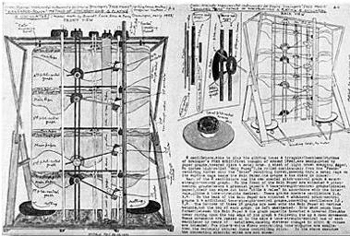by Mike Telin & Daniel Hathaway
It’s common for people who don’t like contemporary music to describe it as “noise,” but in 1913, the Italian painter and forward-thinker Luigi Russolo proclaimed intentionally-created noise to be the concert music of the future. In his Futurist Manifesto, L’arte dei rumori (The Art of Noises), Russolo summarizes the evolution of Western music and arrives at a radical conclusion:
Ancient life was all silence. In the 19th Century, with the invention of machines, Noise was born. Today, Noise is triumphant and reigns sovereign over the sensibility of men…As it grows ever more complicated today, musical art seeks out combinations more dissonant, stranger, and harsher for the ear. Thus, it comes ever closer to the noise-sound…We must break out of the limited circle of sounds [of the orchestra] and conquer the infinite variety of noise-sounds.
To accomplish this, Russolo developed an “Orchestra of Future Noise Intoners” or “Intonarumori,” first unveiled at Milan’s Futurist headquarters, the Casa Rossa in Milan, on August 11, 1913. On Friday, January 16 at 7:30 in Gartner Auditorium at the Cleveland Museum of Art, sixteen modern reconstructions of Russolo’s wooden, hand-cranked sound boxes with conical metal speakers will be heard in a concert of music by ten composers, including the sole surviving fragment of a piece by Russolo himself.

The original Intonarumori, Russolo at left.
The inspiration to reconstruct the Intonarumori (the original instruments were lost during World War II) was the Performa 09 Biennial in San Francisco that marked the centennial of Italian Futurism. It became a special project for Italian musicologist Luciano Chessa, who teaches music history and literature at the San Francisco Conservatory and will conduct the Orchestra on Friday. Chessa has also published Ruigi Russolo, Futurist: Noise, Visual Arts and the Occult, the first book devoted to Russolo and his Art of Noises.
Planning the reconstruction of the instruments wasn’t easy, because the original plans had also vanished. Chessa had to work from two photographs, a drawing of the interior of one of the instruments (above), some sketches, contemporary recordings, and earwitness accounts of what the Intonarumori sounded like. Plus a consideration of Russolo’s table of the six families of Noises that his Futurist Orchestra should be able to produce:
- Roars, Thunderings, Explosions, Hissing roars, Bangs, Booms
- Whistling, Hissing, Puffing
- Whispers, Murmurs, Mumbling, Muttering, Gurgling
- Screeching, Creaking, Rustling, Buzzing, Crackling, Scraping
- Noises obtained by beating on metals, woods, skins, stones, pottery, etc.
- Voices of animals and people, Shouts, Screams, Shrieks, Wails, Hoots, Howls, Death rattles, Sobs
The boxes used different mechanisms inside to produce these effects. Some of the sounds were generated by a wheel touching a string attached to a drum — like a hurdy-gurdy. Some instruments featured a handle on top that varied the string tension. Russolo developed a new notation system for the Intonarumori — the first example of a “graphic score” in the twentieth century.

Russolo’s Fragment (Risveglio di una città, 1913)
The sixteen reproductions were crafted by California luthier Keith Cary and first heard in a concert by Performa 09 at the San Francisco Museum of Modern Art on October 6, 2009. The instruments were played the following month at New York’s Town Hall, then in Italy the following year. Other reconstructions of Russolo’s Noise Intoners have since been made in Pittsburgh, Italy and the Netherlands.
On Friday, the Intonarumori will be played by the University of Maine at Farmington’s Experimental Arts Ensemble (Gustavo Aguilar, director), joined by seven Cleveland musicians. The program will feature the first performances of Joshua Carro’s Her slow gasp (2013) and Christopher Burns’s Three Standard Stoppages (2014), as well as pieces by Teho Teardo, Gregory Moore, Carlo Carrà, Raffaele Guadagnin, Paolo Buzzi and Filippo Tommaso Marinnetti. Luciano Cessa’s own Vathek on the Edge of the Chasm and Luigi Russolo’s Fragment from Risveglio di una città (Awakening of a City) will bring a unique evening of Noises to its conclusion.
Published on ClevelandClassical.com January 14, 2015.
Click here for a printable copy of this article





